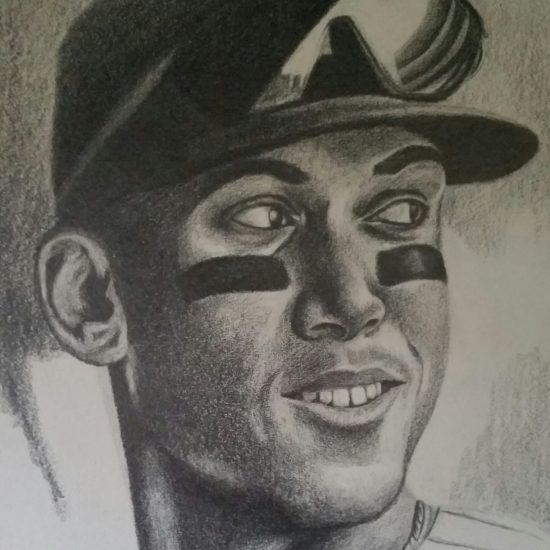This past offseason, Pitcher List introduced Pitch Level Value, or PLV, a new metric that assesses player performance by grading outcomes on the single pitch level. If you’re new to it, you can read Nick Pollack’s primer on PLV here.
You’ll find the definitions below. Grades are on a 20-80 scale.
Swing Aggression: How much more often a hitter swings at pitches, given the swing likelihoods of the pitches they face.
Strikezone Judgement: The “correctness” of a hitter’s swings and takes, using the likelihood of a pitch being a called strike (for swings) or a ball/HBP (for takes).
Decision Value (DV): Modeled value (runs per 100 pitches) of a hitter’s decision to swing or take, minus the modeled value of the alternative.
Contact Ability: A hitter’s ability to make contact (foul strike or BIP), above the contact expectation for each pitch.
Power: Modeled number of extra bases (xISO on contact) above a pitch’s expectation, for each BBE.
Hitter Performance (HP): Runs added per 100 pitches seen by the hitter (including swing/take decisions), after accounting for pitch quality.
Pitch Level Value (PLV): Estimated value of all pitches, based on the predicted outcome of those pitches (0-10, 5 is league average).
Pitch Level Average (PLA): Value of all pitches (ERA Scale), using IP and the total predicted run value of pitches thrown.
Pitch type PLA: Value of a given pitch type (ERA scale), using total predicted run values and an IP proxy for that pitch type (pitch usage % x Total IP).
(Note: All PLV data is current through Thursday 5/25).
This week will survey the top power hitters according to PLV and the top fastballs so far. We’ll also look at Nolan Gorman’s breakout and the struggles of Michael Harris II. But first will start with two Blue Jay pitchers who seem to be going in different directions.
Berríos’ resurgence has been a terrific boost for the Blue Jays. He’s posted a 2.81 ERA and 1.13 WHIP over his last four starts, more or less the opposite of the ghastly ratios he produced last year. If you’re wondering if this is a mirage, consider this: His PLV for the season (898 pitches) is 5.25 which ranks 15th among pitchers with at least 800 pitches thrown.
His PLA of 2.71 is tied with JP Sears for 12th among pitchers with at least 800 pitches.
How did Berríos grade out last season? Actually, not as bad as you might suspect given his 5.23 ERA and 1.42 WHIP.
Last season, his PLV of 5.03 ranked 23rd among pitchers with at least 2,000 pitches. Just ahead of him were Brandon Woodruff and Alex Wood at 5.04.
I don’t have a great answer as to why the results have been so drastically different between this year and last. But the best I can come up with based on his pitch-type PLA grades is that his curveball has taken a step forward. Among pitchers with at least 800 pitches, his curveball PLA of 1.84 ranks third behind Marcus Stroman (1.84) and George Kirby (1.64).
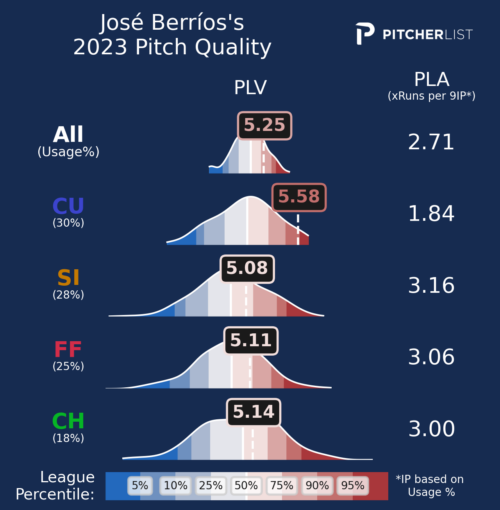
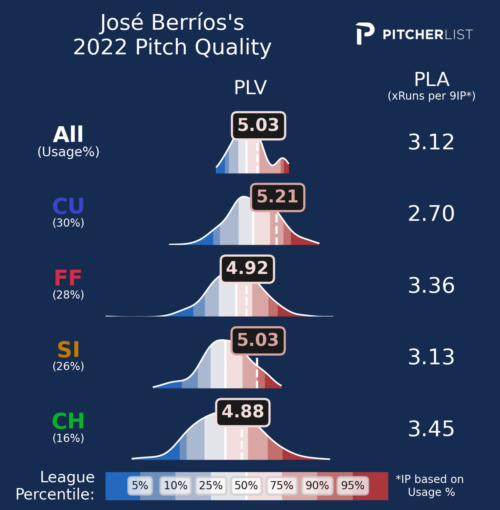
His four-seamer has also been a bit better this year too. Another way to look at it is his Quality pitch% – bad pitch%. A quality pitch is a pitch with a PLV of 5.5 or better. A PLV under 4.5 is considered a bad one. The average QP-BP% is about 7%. Last year, Berríos’ four-seamer had a 6.6% QP-BP%, slightly below average. This year, it’s up to 13.1%.
I think Berríos is just a case of a really good pitcher who, for whatever reason, had a bad season. Given that his PLV grades were actually fairly decent last year and are even better this season, I’m feeling cautiously optimistic about his outlook.
A tale of Blue Jays. After his latest dud against the Rays this past Thursday, Manoah has a 5.53 ERA and 1.79 WHIP. His PLV grades are not good. That’s an understatement. Manoah has the lowest PLV among any starter with at least 800 pitches. He’s had just one start (4/22 @ NYY) that has earned a PLV above 5.00.
Manoah also has the third-worst bad pitch % at 41.4%. The two who are worse are Tylor Megill (42.2%) and Ken Waldichuk (42%).
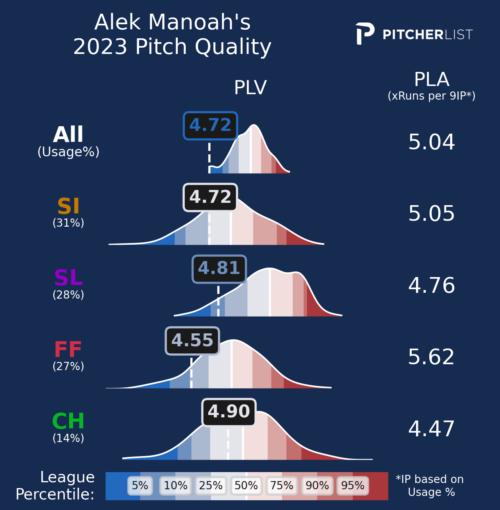
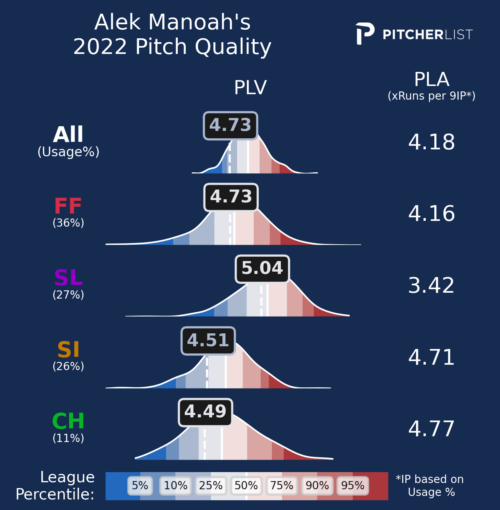
In hindsight, regression seemed likely considering his grades last year. But, this sort of metamorphosis is stunning.
The 23-year-old Cardinal is fourth among qualifiers with a 1.002 OPS. He’s shown some good improvement across his hitter metrics too.
Although it’s improved some this year, Gorman still has well-below-average contact so not expanding the zone will be critical. So far, so good as noted by bumps in DV and SZ Judgment. You can see it in his chase rate, which has gone down from 32.6% to 25.7% this year. We saw his plate discipline trending in the right direction toward the end of last year (below) and he seems to have carried it over into this year.
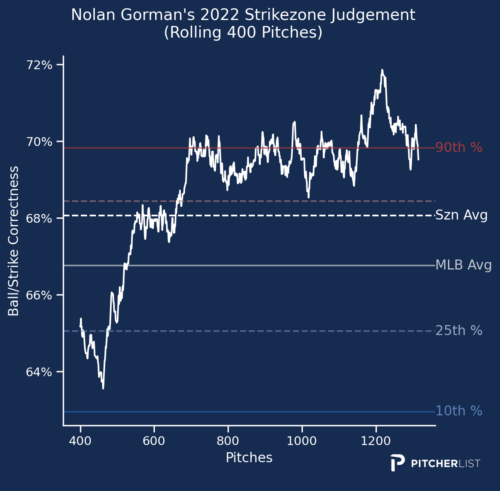
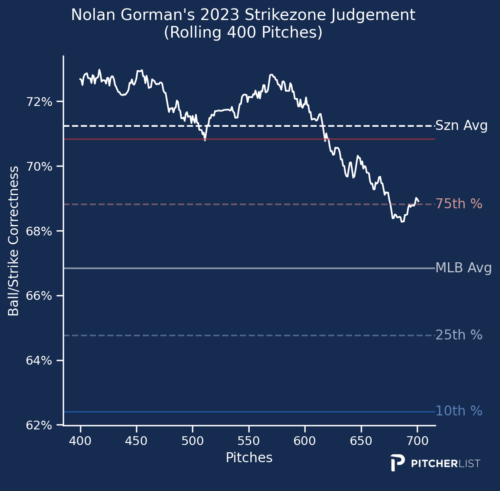 The recent dip (above) might be a concern or it might just be a blip. But given that SZ Judgment generally becomes less noisy at around 500 pitches, I think it’s only a fluctuation (hopefully). The more important thing is that he’s still above the 75th percentile. If he can maintain that, it should bode well for his outlook.
The recent dip (above) might be a concern or it might just be a blip. But given that SZ Judgment generally becomes less noisy at around 500 pitches, I think it’s only a fluctuation (hopefully). The more important thing is that he’s still above the 75th percentile. If he can maintain that, it should bode well for his outlook.
Last year’s NL Rookie of the Year has been a disappointment, to say the least. Note that Harris II has only seen 358 pitches, that’s a bit less than the ideal sample size for things like DV and SZ Judgment (~500 pitches). But I know that he’s someone who a lot of people are curious about given his cold start so I wanted to take a look at what we’ve seen so far this year.
I suppose a potential silver lining is that he’s shown better quality swings and takes, which was a clear weakness last year. But despite swinging at better pitches, his whiff rate is up noted by a drop in Zone contact from 85.3% to 74% (the MLB average is 83.4%). And as you might’ve guessed by the one home run, his power hasn’t shown up at all.
The results are undeniably bad. He’s hitting .165 with a .480 OPS. Horrid. However, I do think it’s important to remember that it’s been all of 28 games and 101 plate appearances. That’s not to say I think he rebounds. But more to emphasize that our picture of him is very unsettled at the moment. Is it possible that pitchers have found a hole in his swing? Sure. Maybe he needs an offseason to readjust. I don’t know. He’s working with Chipper Jones to fix his swing, hitting the other way being the emphasis.
He also had a stint on the IL with a back injury, making things even more murky. At what point does this season take precedence and last year begins to seem like a mirage? For my money, that’s always the toughest question to answer. Everybody has a different breaking point. But it’s a long season and I’m not there yet.
Top Power Performers
Let’s look at who is adding extra bases with every swing.
Patrick Wisdom has really hit the skids lately as the strikeouts (35 contact) have caught up with him, but there’s no denying the power when he connects.
Joey Gallo seems back to his A-game with better swings and takes (60 DV) and a good eye (65 SZ Judgement). He’s also been swinging more this year with a 6.3% swing aggression which is up from -0.4% last year.
The two interesting small sample-size players are Jose Siri and Trayce Thompson. Klay’s brother is on the outside looking in for playing time on the Dodger bench, but Siri might be worth your attention. You know he can steal bases and he’s showing a ton of power although it’s coming with a boatload of strikeouts (30 contact).
I lied, there’s another small sample surprise and it’s another Tampa Bay Ray. Luke Raley has crushed ten home runs this year in a strong-side platoon role that probably makes him better suited in deep, daily lineup formats.
And, of course, Jake Burger. The holes in his approach are glaring (35 contact, 30 SZ Judgment, and 30 DV) but so too is his power.
Nothing too surprising here as we round out the 70-grade power hitters.
There’s our guy from earlier Nolan Gorman. Jorge Soler has seen his roster percentage spike recently. He looks to have fully rebounded after a lost first year in Miami with a back injury.
Kerry Carpenter was sent to the IL earlier with a shoulder injury but he could be an interesting name to file away once he returns to the Tigers.
Similarly, Joc Pederson is also on the IL with a hand injury. His batted profile is pretty electric with a 98th percentile xwoBACON. I’d keep his name circled once he gets back. He’s always a very useful player in daily formats.
J.D. Martinez has picked up some power this year (98th percentile xwoBACON) but it looks like it might have come at the expense of strikeouts (40 contact).
Garrett had a pretty good showing last year with a 3.58 ERA and 1.25 WHIP across 17 starts.
After beginning May with a rough start against Atlanta, he’s posted a 2.91 ERA and 1.06 WHIP across his last four. I’m always a fan of pitchers with low walk rates (5.3%), so he’s piqued my interest.
He’s got a pretty interesting repertoire highlighted by a slider that’s returned a 45.1% chase rate, a 36% zone rate, and a 24% SwStr%.
The cutter has also been impressive with a 55.8% zone rate and a 17.7% SwStr%.
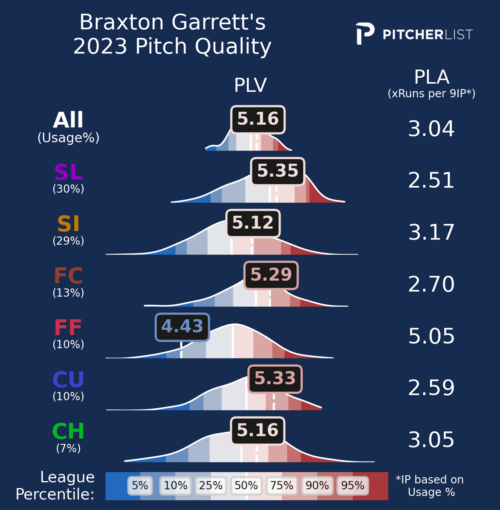
Don’t look now but Ozuna might be a thing again. He’s shown some improvements in DV this year (60) relative to last season (45) and in SZ Judgment (45 to 55).
He still has a lot of power (65) backed by a 90th percentile xwoBACON. He could still be a difference-maker in RBIs.
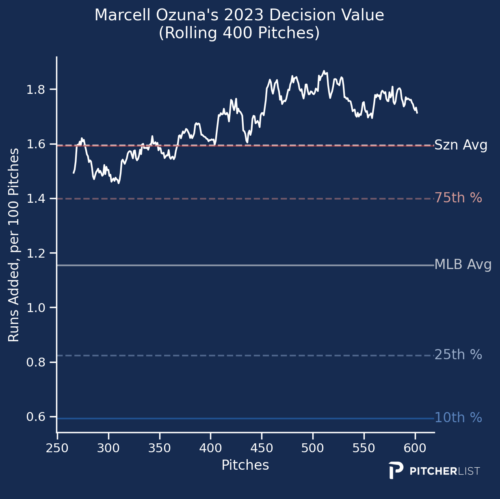
Cano don’t ya know?
The Orioles found another gem in the back of their bullpen. Among all pitchers with a minimum of 300 pitches, Yennier Cano leads the way with a 5.77 PLV. His changeup has basically broken everything with a PLA of -0.05. Although, he’s only thrown 316 pitches, so it’s not quite an ideal sample.
Meanwhile, Félix Bautista’s (450 total pitches) signature pitch the splitter, has not graded out nearly as well this year with a 4.90 PLA compared to last year’s 3.13.
Fastballs
We’ll end with a list of this year’s best heaters by PLA (minimum 800 total pitches).
Let’s take a moment to appreciate Spencer Strider. His heater is in a tier of its own.
It’s amazing what a little extra velocity can do. López’s bump from 93.5 to 95 has helped his fastball spike to a 2.72 PLA compared to 3.80 last year.
It’s great to see Freddy Peralta healthy again. His heater velocity is up nearly two full ticks this year and it’s resulted in his PLA going down from 3.80 to 2.60.
Yusei Kikuchi is the fun one on this list. Last season, Kikuchi’s heater earned a 4.32 PLA. This year, his fastball has returned a 2.32 PLA and a 15.1% SwStr rate (89th percentile).
If you’re sad about Nestor Cortes, and his 5.30 ERA, you can perhaps find solace that he would be on this list if it were one item longer. His 2.78 fastball PLA is even better than last year’s 3.04.
Photo by Nick Wosika/Icon Sportswire | Adapted by Justin Paradis (@JustParaDesigns on Twitter)

